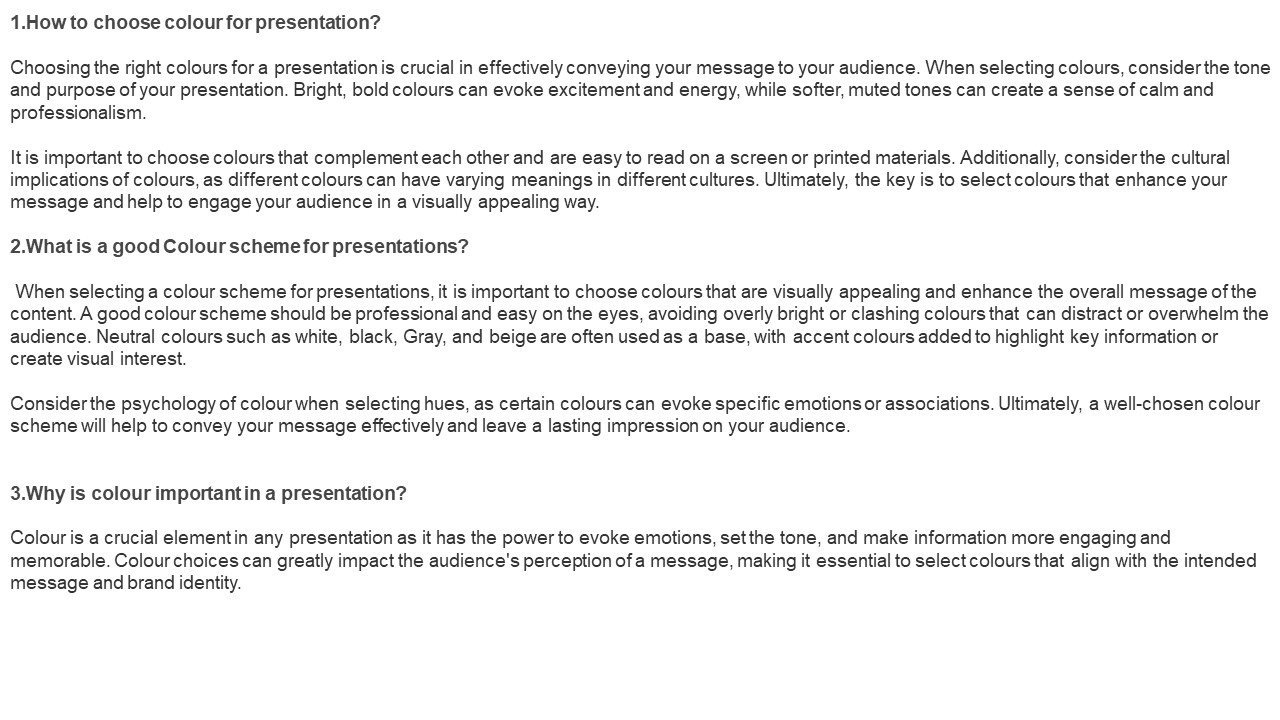Enhancing Your Business Presentations - PowerPoint PPT Presentation
Title:
Enhancing Your Business Presentations
Description:
Enhancing your business presentations is crucial for effectively communicating ideas and engaging your audience. Begin by clearly defining your objectives and tailoring your content to meet the needs of your audience. Utilize visual aids, such as graphs and infographics, to reinforce key points and maintain attention. Incorporate storytelling techniques to create a relatable narrative that resonates with listeners. Practice your delivery to ensure confidence and mastery of the material, allowing for a natural flow during the presentation. – PowerPoint PPT presentation
Number of Views:0
Title: Enhancing Your Business Presentations
1
1.How to choose colour for presentation?
Choosing the right colours for a presentation
is crucial in effectively conveying your message
to your audience. When selecting colours,
consider the tone and purpose of your
presentation. Bright, bold colours can evoke
excitement and energy, while softer, muted tones
can create a sense of calm and professionalism.
It is important to choose colours that
complement each other and are easy to read on a
screen or printed materials. Additionally,
consider the cultural implications of colours, as
different colours can have varying meanings in
different cultures. Ultimately, the key is to
select colours that enhance your message and help
to engage your audience in a visually appealing
way. 2.What is a good Colour scheme for
presentations? When selecting a colour scheme
for presentations, it is important to choose
colours that are visually appealing and enhance
the overall message of the content. A good colour
scheme should be professional and easy on the
eyes, avoiding overly bright or clashing colours
that can distract or overwhelm the audience.
Neutral colours such as white, black, Gray, and
beige are often used as a base, with accent
colours added to highlight key information or
create visual interest. Consider the psychology
of colour when selecting hues, as certain colours
can evoke specific emotions or associations.
Ultimately, a well-chosen colour scheme will help
to convey your message effectively and leave a
lasting impression on your audience. 3.Why is
colour important in a presentation? Colour is a
crucial element in any presentation as it has the
power to evoke emotions, set the tone, and make
information more engaging and memorable. Colour
choices can greatly impact the audience's
perception of a message, making it essential to
select colours that align with the intended
message and brand identity.
2
Utilizing a harmonious colour palette can
enhance the overall aesthetic appeal of a
presentation and create a cohesive and visually
pleasing experience for the audience.
Additionally, colour can be used strategically to
highlight key information, create emphasis, and
guide the viewer's attention to critical points.
Therefore, careful consideration of colour
choices is integral to creating a successful and
impactful presentation. 4.What are the rules for
presentation colours? When it comes to choosing
colours for presentations, it is important to
adhere to certain rules in order to create a
cohesive and visually appealing design. One of
the key principles to keep in mind is contrast -
using colours that stand out from one another
helps to make important information easily
readable. It is also important to consider the
audience and context of the presentation when
selecting colours, as different industries and
demographics may respond better to certain colour
schemes. Additionally, it is best to limit the
number of colours used in a presentation to avoid
overwhelming the viewer. By following these
guidelines, presenters can create impactful and
engaging visuals that effectively communicate
their message. 5.What are the best colours for a
business presentation? When it comes to
selecting the best colours for a business
presentation, it is important to consider the
impact they can have on your audience. Neutral
colours such as Gray, white, and black are often
recommended as they convey professionalism and
sophistication. Additionally, using a pop of
colour, such as blue or green, can help to grab
the attention of your audience and make key
information stand out. It is also crucial to
consider the psychological effects of colours
for example, blue is often associated with trust
and loyalty, while red can evoke feelings of
urgency or excitement. Ultimately, the best
colours for a business presentation will depend
on the message you are trying to convey and the
emotions you want to evoke in your audience.
3
https//visualsculptors.com/ https//visualsculp
tors.com/our-portfolio/































